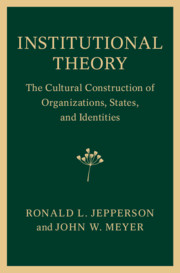Book contents
- Institutional Theory
- Institutional Theory
- Copyright page
- Contents
- Figures
- Preface
- Credits
- Part I Introduction
- 1 Introduction:
- Part II Institutional Theory: Its Role in Modern Social Analysis
- Part III The Institutional Level of Analysis
- Part IV Institutions of Modernity and Postmodernity: The Construction of Actors
- Part V Conclusion
- Index
- References
1 - Introduction:
Cultural Institutionalism
from Part I - Introduction
Published online by Cambridge University Press: 22 March 2021
- Institutional Theory
- Institutional Theory
- Copyright page
- Contents
- Figures
- Preface
- Credits
- Part I Introduction
- 1 Introduction:
- Part II Institutional Theory: Its Role in Modern Social Analysis
- Part III The Institutional Level of Analysis
- Part IV Institutions of Modernity and Postmodernity: The Construction of Actors
- Part V Conclusion
- Index
- References
Summary
A new basic introduction to “sociological neoinstitutionalism,” placing the line of thought in intellectual context, and discussing the linkages of the core ideas to empirical research.
Keywords
- Type
- Chapter
- Information
- Institutional TheoryThe Cultural Construction of Organizations, States, and Identities, pp. 3 - 24Publisher: Cambridge University PressPrint publication year: 2021
References
- 2
- Cited by

